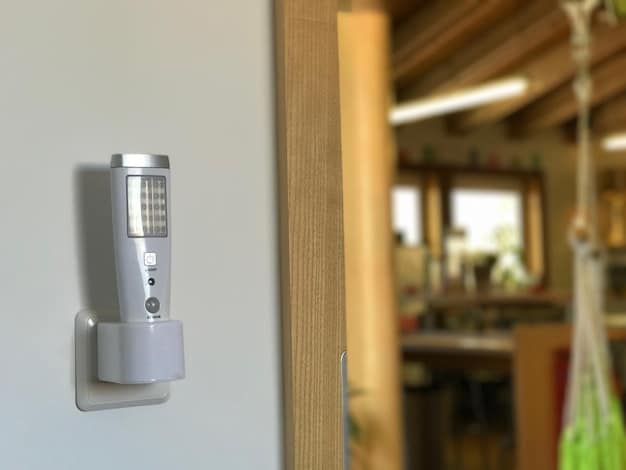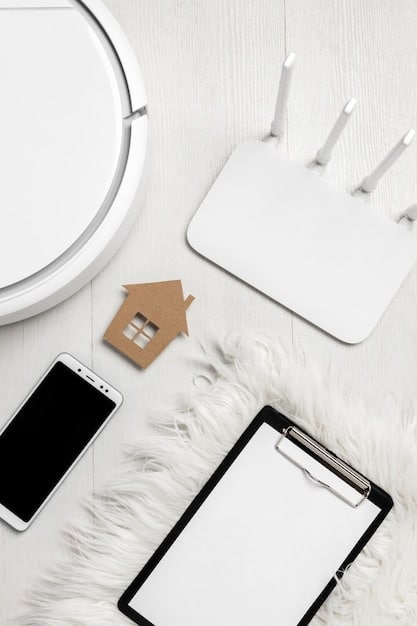DIY Home Security System: Install a Wireless System & Skip Monthly Fees

Installing a DIY home security system allows you to protect your home without the recurring costs of monthly monitoring fees, offering a cost-effective and customizable security solution.
Considering a home security upgrade? A DIY home security system: install a wireless security system with no monthly fees can be a game-changer. It empowers you to take control of your home’s safety without the burden of recurring monthly charges.
Why Choose a DIY Home Security System?
Choosing a DIY home security system is a smart move for homeowners looking to save money and maintain control over their security. With advancements in technology, setting up a robust security system yourself has never been easier.
The main draw for many is the elimination of monthly fees. Let’s delve into the cost savings and other compelling reasons.
Cost Savings Over Time
One of the most attractive benefits of a DIY system is the significant cost savings. While professionally monitored systems require monthly fees, DIY systems involve a one-time purchase of equipment and no ongoing charges.
Here’s a simple breakdown of the potential long-term savings:
- No Monthly Fees: Pay only for the equipment, avoiding recurring costs.
- Long-Term Savings: Over several years, the savings can amount to thousands of dollars.
- Budget-Friendly Options: Various affordable DIY kits are available to suit different budgets.
Full Control Over Your Security
DIY systems allow for complete customization. You select the equipment, decide where it goes, and configure the settings to match your specific needs.
Having control can be really empowering, ensuring you customize the setup with your needs.
- Customizable Settings: Tailor the system to your home layout and security preferences.
- Equipment Choice: Select cameras, sensors, and alarms based on your particular needs.
- Flexible Upgrades: Easily add or remove components as your security needs change.
DIY home security systems offer considerable advantages: significant cost savings and complete control over your home’s safety. You can customize the equipment and settings to suit your property’s specific layout and security needs.
Essential Components of a Wireless DIY Security System
A robust DIY home security system relies on several key components working together seamlessly. Understanding each component’s role ensures you assemble a system that effectively protects your home.
Let’s examine the main elements you’ll need to consider.

Control Panel or Hub
The control panel acts as the central brain, connecting all the sensors and devices. It’s the primary interface for arming, disarming, and monitoring your system.
It is the command center, so look for specific features.
- Wireless Connectivity: Ensures seamless communication between devices.
- User-Friendly Interface: Simplifies the setup and operation process.
- Backup Power: Keeps the system running during power outages.
Entry Sensors
Entry sensors are attached to doors and windows, triggering an alarm when opened. They are indispensable for alerting you to unauthorized access.
Easy to install, they are the first line of defense.
- Magnetic Contacts: Detect when a door or window is opened.
- Tamper Detection: Alerts you if someone tries to remove or disable them.
- Wireless Design: Simple to install without complex wiring.
Motion Detectors
Motion detectors use infrared or microwave technology to identify movement within a specified area. They are ideal for covering large spaces or areas where entry sensors aren’t feasible.
They add an extra layer of protection to the system. These can be configured to cover large amounts of open interior space.
- Pet-Immune Options: Prevents false alarms caused by pets.
- Adjustable Sensitivity: Fine-tune the detection range to suit your environment.
- Wide Coverage Area: Monitors a broad area for suspicious activity.
These essential components collaborate to create a cohesive and effective DIY security strategy. Selecting the appropriate items for your property gives you a robust, custom security solution without the need for costly monthly fees.
Step-by-Step Guide to Installing Your DIY System
Installing a DIY home security system can seem daunting, but breaking the process into manageable steps greatly simplifies it. Proper preparation and a clear understanding of the installation process ensures a smooth experience.
These are the steps you can follow to install a DIY system easily.
Plan Your Setup
Before unboxing anything, map out your security strategy. Identify vulnerable entry points, choose sensor locations, and plan where to place your control panel.
Your plan will lay the foundation for a smooth installation.
- Identify Vulnerable Points: Assess all potential entry points, including doors, windows, and garages.
- Optimal Sensor Placement: Determine the best locations for entry sensors and motion detectors.
- Control Panel Location: Choose a central, secure location for the control panel.
Install Entry Sensors
Entry sensors are typically installed using adhesive strips. Attach one part of the sensor to the door or window frame and the other to the door or window itself.
This is an easy job, just match the sensor pieces.
- Clean Surfaces: Make sure the surfaces are clean and dry before attaching the sensors.
- Align Properly: Ensure the sensor parts align correctly when the door or window is closed.
- Test Functionality: After installation, test each sensor to confirm it’s working.
Set Up Motion Detectors
Motion detectors can be mounted on walls or placed on shelves. Follow the manufacturer’s instructions for optimal placement, considering the detector’s range and field of view.
Make sure they are positioned correctly for accuracy.
- Mount Securely: Use screws or strong adhesive to secure the motion detectors.
- Avoid Obstructions: Ensure nothing blocks the detector’s view.
- Adjust Sensitivity: Calibrate the sensitivity to avoid false alarms from pets or environmental factors.
Following this step-by-step guidance will ensure your DIY installation of a home security system is as smooth and successful as possible. Planning is key, as well as following directions and not skipping steps.
Connecting Your System to Smart Home Devices
Integrating your DIY home security system with smart home devices enhances its functionality and convenience. Connecting these systems allows for automation and remote monitoring.
Connecting is easy, and here are some connections to consider for your system.
Smart Locks
Integrating smart locks with your security system lets you control access to your home remotely. You can lock or unlock doors from your smartphone and receive alerts when someone enters or exits.
Add more control, and use the smart locks to know who is coming and going.
- Remote Access Control: Lock and unlock doors from anywhere.
- Entry Logs: Track who enters and exits your home.
- Automated Locking: Set doors to lock automatically at certain times.
Smart Lighting
Connecting your security system to smart lighting can deter potential intruders. Program lights to turn on when sensors are triggered, giving the impression someone is home.
Make it seem like someone is always home with smart lighting.
- Deter Potential Intruders: Simulate occupancy to discourage burglars.
- Enhanced Visibility: Improve lighting during alarms or emergencies.
- Energy Savings: Control lighting remotely to save energy.

Voice Assistants
Integrating voice assistants like Amazon Alexa or Google Assistant allows you to control your security system with voice commands. Arm or disarm your system, check sensor statuses, and receive security updates using simple voice prompts.
Control your security using just voice commands.
- Hands-Free Control: Manage your security system with simple voice commands.
- Real-Time Updates: Receive voice notifications about security events.
- Convenient Operation: Easily arm or disarm your system while multitasking.
Connecting your DIY system to smart home products adds ease of use and automation. By integrating smart locks, lighting, and voice assistants, your security system becomes more powerful, offering better control and peace of mind.
Troubleshooting Common Issues
Like any electronic system, DIY home security systems can occasionally experience issues. Knowing how to troubleshoot common problems can save time and frustration.
Here are some common issues and how to fix them.
False Alarms
False alarms can be frustrating and disruptive. Common causes include low batteries, improper sensor placement, or sensitivity settings.
The alarm is alarming, but often caused by simple things.
- Check Battery Levels: Replace low batteries in sensors and the control panel.
- Adjust Sensitivity: Lower the sensitivity of motion detectors and entry sensors.
- Secure Sensor Placement: Ensure sensors are securely mounted and properly aligned.
Connectivity Problems
Wireless security systems rely on a stable internet connection. Connectivity issues can prevent sensors from communicating with the control panel or disrupt remote monitoring.
Without connectivity, you can’t use the system, so fix your wifi.
- Check Wi-Fi Connection: Confirm that your Wi-Fi router is functioning correctly.
- Relocate Control Panel: Move the control panel closer to the router to improve signal strength.
- Reboot System: Restart the control panel and sensors to refresh the connection.
Sensor Malfunctions
Sensors can sometimes malfunction due to wear and tear, environmental factors, or physical damage. Regular maintenance and prompt repairs help prevent malfunctions.
Take care of them, so they take care of you.
- Inspect Sensors: Check for physical damage, such as cracks or broken parts.
- Clean Sensors: Dust and debris can interfere with sensor functionality.
- Replace Faulty Sensors: If a sensor consistently malfunctions, replace it promptly.
By addressing common challenges, you can keep your DIY system functioning optimally. Regular checks, maintenance, and understanding possible causes ensures it is always active.
Future Trends in DIY Home Security
The DIY home security market is constantly evolving, driven by technological advancements and changing consumer needs. Staying informed about future trends ensures you adopt the latest and most effective security measures.
Let’s explore some futuristic trends in home security.
AI-Powered Security
Artificial intelligence (AI) is transforming home security. AI-powered systems can distinguish between genuine threats and harmless activities, reducing false alarms and improving overall accuracy.
AI, or artificial intelligence, is transforming the way we assess security.
- Facial Recognition: Identifies authorized individuals and alerts you to intruders.
- Behavior Analysis: Learns typical patterns and detects unusual activities.
- Predictive Security: Anticipates potential threats based on historical data.
Enhanced Cybersecurity
As smart home devices become more prevalent, cybersecurity becomes increasingly important. Future DIY security systems will incorporate advanced encryption and security protocols to protect against hacking and data breaches.
Cybersecurity needs to be a priority as more smart devices are used.
- End-to-End Encryption: Protects data transmitted between devices and the cloud.
- Multi-Factor Authentication: Adds an extra layer of security to remote access.
- Regular Updates: Firmware updates address vulnerabilities and improve security.
Integration with 5G Networks
The rollout of 5G networks will enable faster and more reliable data transmission, improving the performance of wireless security systems. Faster speeds and lower latency will enhance real-time monitoring and response capabilities.
5G can greatly increase speed, and security.
- Faster Data Transmission: Enables faster video streaming and real-time alerts.
- Improved Reliability: Ensures consistent connectivity for sensors and devices.
- Expanded Coverage: Extends the range and capabilities of wireless security systems.
Anticipating future trends in DIY home security allows you to get the newest and most useful features. AI-powered systems, enhanced cybersecurity, and the integration with 5G networks show how evolving tech will improve security for your home.
| Key Point | Brief Description |
|---|---|
| 💰 Cost Savings | No monthly fees, one-time equipment cost. |
| 🛠️ Customization | Choose and install equipment to your needs. |
| 📱 Smart Integration | Connect to smart locks, lighting, and voice assistants. |
| 💡 Troubleshooting | Fix false alarms, connectivity, and sensor issues. |
Frequently Asked Questions
▼
The primary benefits include significant cost savings by avoiding monthly fees, full control over your security setup, and the ability to customize the system to fit your specific needs.
▼
Essential components include a control panel or hub, entry sensors for doors and windows, motion detectors for interior spaces, and security cameras for both indoor and outdoor monitoring.
▼
Prevent false alarms by ensuring proper sensor placement, regularly checking and replacing batteries, and adjusting the sensitivity settings on motion detectors to avoid triggering by pets.
▼
Yes, you can integrate your DIY system with smart devices such as smart locks, smart lighting, and voice assistants like Amazon Alexa or Google Assistant for enhanced automation and control.
▼
Future trends include the integration of artificial intelligence for threat detection, enhanced cybersecurity measures to protect against hacking, and the use of 5G networks for faster and more reliable connectivity.
Conclusion
A DIY home security system offers an effective way to protect your home. This solution provides security with flexibility and control. By eliminating monthly fees and customizing the system, you can achieve peace of mind.





